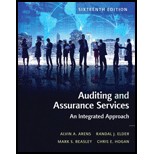
Auditing and Assurance Services (16th Edition)
16th Edition
ISBN: 9780134065823
Author: Alvin A. Arens, Randal J. Elder, Mark S. Beasley, Chris E. Hogan
Publisher: PEARSON
expand_more
expand_more
format_list_bulleted
Question
Chapter 8, Problem 26.2MCQ
To determine
Identify the correct option for the given statement.
Expert Solution & Answer
Want to see the full answer?
Check out a sample textbook solution
Students have asked these similar questions
Job 528 was one of the many jobs started and completed during the year. The job required $11,200 in direct materials and 40 hours of direct labor time at a total direct labor cost of $12,600. If the job contained five units and the company billed at 65% above the unit product cost on the job cost sheet, what price per unit would have been charged to the customer?
Calculate the net cash provided by operating activities of this financial accounting question
given answer of this General accounting question
Chapter 8 Solutions
Auditing and Assurance Services (16th Edition)
Ch. 8 - Prob. 1RQCh. 8 - Prob. 2RQCh. 8 - Prob. 3RQCh. 8 - Prob. 4RQCh. 8 - Prob. 5RQCh. 8 - Prob. 6RQCh. 8 - Prob. 7RQCh. 8 - Prob. 8RQCh. 8 - Prob. 9RQCh. 8 - Prob. 10RQ
Ch. 8 - Prob. 11RQCh. 8 - Prob. 12RQCh. 8 - Prob. 13RQCh. 8 - Prob. 14RQCh. 8 - Prob. 15RQCh. 8 - Your client, Harper Company, has a contractual...Ch. 8 - Prob. 17RQCh. 8 - Prob. 18RQCh. 8 - Prob. 19RQCh. 8 - Prob. 20RQCh. 8 - Prob. 21RQCh. 8 - Prob. 22RQCh. 8 - Prob. 23RQCh. 8 - Prob. 24RQCh. 8 - Prob. 25.1MCQCh. 8 - Prob. 25.2MCQCh. 8 - Prob. 25.3MCQCh. 8 - Prob. 26.1MCQCh. 8 - Prob. 26.2MCQCh. 8 - Prob. 26.3MCQCh. 8 - Which one of the following statements is correct...Ch. 8 - Prob. 27.2MCQCh. 8 - Prob. 27.3MCQCh. 8 - Prob. 28.1MCQCh. 8 - Prob. 28.2MCQCh. 8 - Prob. 28.3MCQCh. 8 - Prob. 29DQPCh. 8 - Prob. 30DQPCh. 8 - Prob. 31DQPCh. 8 - Your comparison of the gross margin percent for...Ch. 8 - Prob. 33DQPCh. 8 - Prob. 34DQPCh. 8 - Prob. 35DQPCh. 8 - Prob. 36DQPCh. 8 - Prob. 37DQPCh. 8 - Following are statements of earnings and financial...
Knowledge Booster
Similar questions
- Burson Enterprises' May 31 bank reconciliation shows deposits in transit of $850. The general ledger Cash in Bank account shows total cash receipts during June of $48,500. The June bank statement shows total cash deposits of $44,300 (including $1,500 from the collection of a note; the note collection has not yet been recorded by Burson). What amount of deposits in transit should appear in the June 30 bank reconciliation? Helparrow_forwardWhat should be the adjusted cash balancearrow_forwardHii, tutor give me Answerarrow_forward
- General Accountingarrow_forwardJuno Manufacturing produces lamps that require 2.8 standard hours per unit at an hourly rate of $14.00 per hour. If 5,800 units required 15,900 hours at an hourly rate of $13.60 per hour, determine the following: a) Direct labor rate variance b) Direct labor time variance c) Total direct labor cost variancearrow_forwardprovide correct answer of this General accounting questionarrow_forward
- 4 POINTSarrow_forwardIn the month of September, a department had 9,500 units in beginning work in process that were 60% complete. During September, 28,500 units were transferred into production from another department. At the end of September, there were 5,500 units in ending work in process that were 50% complete. Materials are added at the beginning of the process, while conversion costs are incurred uniformly throughout the process. A. The equivalent units of production for materials in September were __. B. The equivalent units of production for conversion costs for September were __.arrow_forwardAnswer ?arrow_forward
- In the month of September, a department had 9,500 units in beginning work in process that were 60% complete. During September, 28,500 units were transferred into production from another department. At the end of September, there were 5,500 units in ending work in process that were 50% complete. Materials are added at the beginning of the process, while conversion costs are incurred uniformly throughout the process. A. The equivalent units of production for materials in September were . B. The equivalent units of production for conversion costs for September were . Need answerarrow_forwardWhat is the correct answer of this a b ? General accounting questionarrow_forwardIf the risk-free rate is 2.5%, the expected market risk premium is 6%, and the company's stock beta is 1.4, what is the company's cost of equity?arrow_forward
arrow_back_ios
SEE MORE QUESTIONS
arrow_forward_ios
Recommended textbooks for you
 Auditing: A Risk Based-Approach to Conducting a Q...AccountingISBN:9781305080577Author:Karla M Johnstone, Audrey A. Gramling, Larry E. RittenbergPublisher:South-Western College Pub
Auditing: A Risk Based-Approach to Conducting a Q...AccountingISBN:9781305080577Author:Karla M Johnstone, Audrey A. Gramling, Larry E. RittenbergPublisher:South-Western College Pub Auditing: A Risk Based-Approach (MindTap Course L...AccountingISBN:9781337619455Author:Karla M Johnstone, Audrey A. Gramling, Larry E. RittenbergPublisher:Cengage Learning
Auditing: A Risk Based-Approach (MindTap Course L...AccountingISBN:9781337619455Author:Karla M Johnstone, Audrey A. Gramling, Larry E. RittenbergPublisher:Cengage Learning


Auditing: A Risk Based-Approach to Conducting a Q...
Accounting
ISBN:9781305080577
Author:Karla M Johnstone, Audrey A. Gramling, Larry E. Rittenberg
Publisher:South-Western College Pub

Auditing: A Risk Based-Approach (MindTap Course L...
Accounting
ISBN:9781337619455
Author:Karla M Johnstone, Audrey A. Gramling, Larry E. Rittenberg
Publisher:Cengage Learning